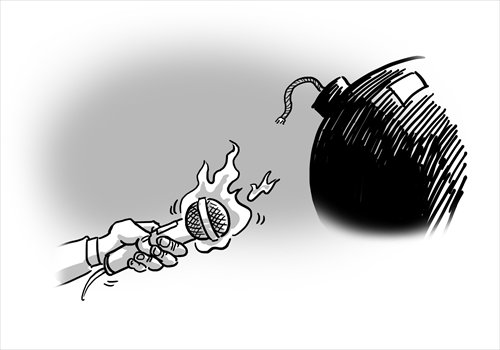Indian journalists filled in information gaps during crisis

Editor's Note:
China and India have long-standing unresolved border issues. The recent tent standoff was eventually resolved diplomatically. But the incident, on which some Indian media took a nationalistic stance, was over-amplified. Two experts contributed their own thoughts on the role played by Indian media in the incident.
Indian media played a much-needed role during recent border tensions between India and China, the largest developing countries in Asia. It filled the information gap left by the government, and reporting ultimately helped push the two sides toward resolution.
Initially, both countries' governments tried to play down the incident.
In India, Prime Minister Manmohan Singh termed it a "localized problem," and the Indian External Affairs Minister Salman Khurshid referred to it as "acne" that could "be addressed by simply applying an ointment."
However, to any observer of India-China relations, the recent crisis was the most serious interaction since the month-long 1962 border clash.
Indian leaders are accountable first to the public and then to the Indian parliament. But the Indian public has long distrusted the government when it comes to dealing with China.
During the incident in Ladakh, the Indian army, as well as the Ministry of External Affairs, failed to offer a full account of the issue.
Press briefings did not provide a transparent and satisfactory report of the negotiations that India was carrying out with PLA officers.
Many Indians, including myself, realized that the media has played a very crucial role in informing and updating us of each and every development in the Daulat Beg Oldi area of Ladakh.
Despite the difficult terrain and the lack of roads and infrastructure in the region, reporters were sent with cameras to the site of the confrontation.
The Indian media, in particular television reports, portrayed the conflict as a wake-up call for the Indian establishment, claiming the Chinese "dragon" was "invading Indian territory."
By contrast, in Chinese mainland, the mainstream media did not take any clear stand on the events in Ladakh. Instead, it blamed the Indian media for fanning the flames.
In reality, Indian media successfully built strong public resistance to this standoff in the disputed region, which India claims is an integral part of its territory.
During the skirmish, the Indian media's anti-China reporting was so extensive that it provoked Indian calls for boycotting Chinese goods.
Apart from the traditional media, social media, particularly Facebook and Twitter, played a very important role in transmitting information and drumming up a response to the crisis among the public.
In recent years, some nationalist organizations have also been very active on social media, as the self-proclaimed "Internet Hindus."
Pressure built up, as did criticism of India's ruling alliance, led by the Congress Party, which was accused of not taking a tough stand.
After a series of corruption scandals and a general lack of governance, Singh's government is trying to save face and seeking a fresh mandate at the end of this year. Ongoing tension at the border would have dashed these hopes.
In fact, the top leadership in both countries currently faces serious domestic political and economic challenges. By resolving the dispute diplomatically, the neighbors affirmed their commitment to maintain peace across the border and focus on economic development.
Although peace has once again prevailed across the Himalayas, questions raised by the Indian media remain unanswered.
The media has stirred up an interest among the public for the truth. The Indian people want to know the causes and effects of this latest border standoff and what compromises were made in the negotiation process that led to the final withdrawal of both sides.
When the Indian government's stance is unclear, journalists can step in to put pressure on political leaders and bureaucrats and to bring facts to the public.
How much the media has been able to influence the making of Indian foreign policy has yet to be studied empirically, but the media's recent campaign about this border conflict has reinforced the trust the Indian people have put in it.
Rather than the nationalism and jingoism of the past, the role of media in India was different this time. The Indian media highlighted the issue of this conflict, reporting it as breaking news until change was made.
In a large democracy like India, the power of the media cannot be underestimated.
The author is an assistant professor at Peking University. opinion@globaltimes.com.cn
Counterpoint:Media's sensational reporting stirred potential conflict